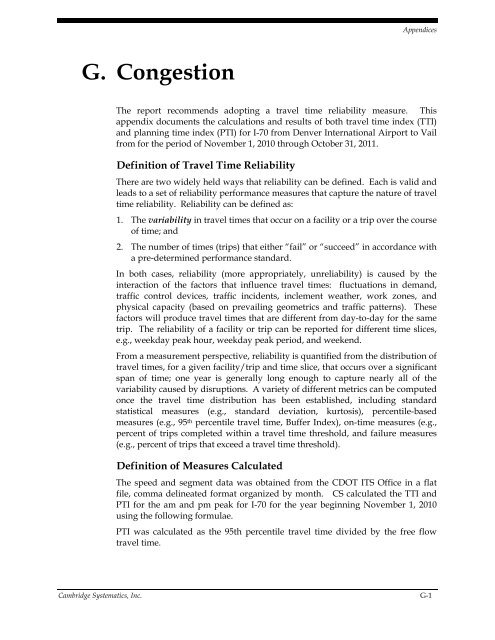CDOT Performance Data Business Plan - Cambridge Systematics
CDOT Performance Data Business Plan - Cambridge Systematics
CDOT Performance Data Business Plan - Cambridge Systematics
You also want an ePaper? Increase the reach of your titles
YUMPU automatically turns print PDFs into web optimized ePapers that Google loves.
Appendices<br />
G. Congestion<br />
The report recommends adopting a travel time reliability measure. This<br />
appendix documents the calculations and results of both travel time index (TTI)<br />
and planning time index (PTI) for I-70 from Denver International Airport to Vail<br />
from for the period of November 1, 2010 through October 31, 2011.<br />
Definition of Travel Time Reliability<br />
There are two widely held ways that reliability can be defined. Each is valid and<br />
leads to a set of reliability performance measures that capture the nature of travel<br />
time reliability. Reliability can be defined as:<br />
1. The variability in travel times that occur on a facility or a trip over the course<br />
of time; and<br />
2. The number of times (trips) that either “fail” or “succeed” in accordance with<br />
a pre-determined performance standard.<br />
In both cases, reliability (more appropriately, unreliability) is caused by the<br />
interaction of the factors that influence travel times: fluctuations in demand,<br />
traffic control devices, traffic incidents, inclement weather, work zones, and<br />
physical capacity (based on prevailing geometrics and traffic patterns). These<br />
factors will produce travel times that are different from day-to-day for the same<br />
trip. The reliability of a facility or trip can be reported for different time slices,<br />
e.g., weekday peak hour, weekday peak period, and weekend.<br />
From a measurement perspective, reliability is quantified from the distribution of<br />
travel times, for a given facility/trip and time slice, that occurs over a significant<br />
span of time; one year is generally long enough to capture nearly all of the<br />
variability caused by disruptions. A variety of different metrics can be computed<br />
once the travel time distribution has been established, including standard<br />
statistical measures (e.g., standard deviation, kurtosis), percentile-based<br />
measures (e.g., 95 th percentile travel time, Buffer Index), on-time measures (e.g.,<br />
percent of trips completed within a travel time threshold, and failure measures<br />
(e.g., percent of trips that exceed a travel time threshold).<br />
Definition of Measures Calculated<br />
The speed and segment data was obtained from the <strong>CDOT</strong> ITS Office in a flat<br />
file, comma delineated format organized by month. CS calculated the TTI and<br />
PTI for the am and pm peak for I-70 for the year beginning November 1, 2010<br />
using the following formulae.<br />
PTI was calculated as the 95th percentile travel time divided by the free flow<br />
travel time.<br />
<strong>Cambridge</strong> <strong>Systematics</strong>, Inc. G-1

















